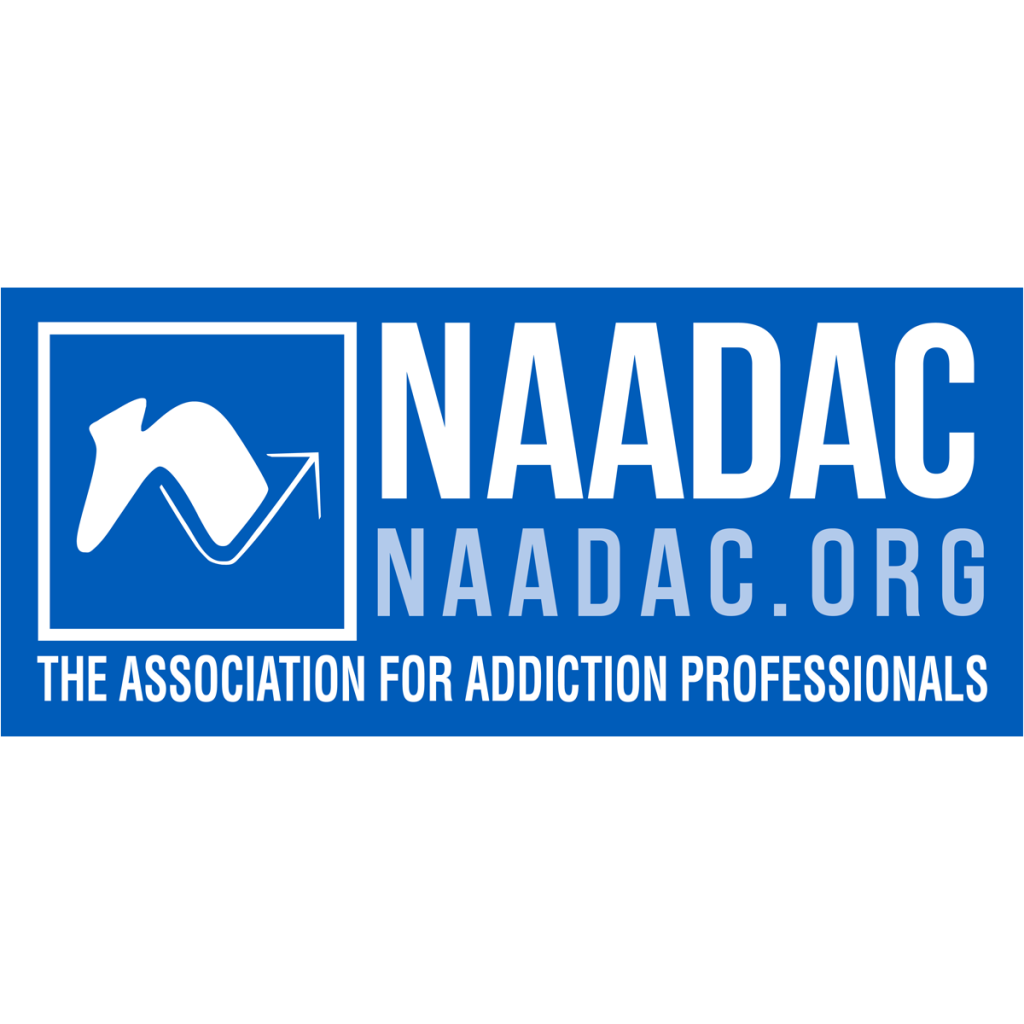Everything You Need to Know About Buprenorphine
GET HELP TODAY!
100% Confidentiality Guaranteed


Table of Contents
Everything You Need to Know About Buprenorphine
Withdrawing from opioids is often much more manageable when symptoms are being controlled with an addiction medication like Buprenorphine. But what exactly is Buprenorphine and what does it do? Here’s everything you need to know about the addiction medication Buprenorphine.
What is Buprenorphine?
Buprenorphine is an FDA-approved medication that provides acute and chronic pain relief caused by withdrawal from opioid dependence. It is also a Schedule III controlled substance which means it has a low to moderate potential for abuse. In combination with professional supervision and behavioral therapy, buprenorphine provides safe and controlled withdrawal from opioid addiction.
Lorem ipsum dolor sit amet, consectetur adipiscing elit. Ut elit tellus, luctus nec ullamcorper mattis, pulvinar dapibus leo.
Types
There are several different modes by which Buprenorphine can be administered. These modes are dependent on a couple of key factors but the most decisive factor is the severity of the addiction. Furthermore, these types of administration include injection, oral, and transdermal.
Benefits of Long-Acting Buprenorphine (Sublocade®, Buvidal®)
Long-acting injectable and implantable formulations (e.g., Sublocade, Buvidal, Probuphine) provide steady buprenorphine release over weeks or months. This improves adherence, reduces the risk of medication diversion, and eliminates the need for daily dosing. Clinical studies show these options lead to higher retention and fewer missed doses compared to daily oral buprenorphine
Injection
Buprenorphine injections are extended release, meaning they are long-lasting and slowly release the medicine over a period of 26 to 30 days. As a result, these injections are meant to be administered on a monthly basis.
Oral
A physician may administer Buprenorphine orally either in the form of sublingual tablets or strips. Tablets are placed under the tongue and given time to dissolve, increasing maximum absorption. If the tablets are swallowed, they will still have an effect but much less than initially desired. Additionally, strips are placed on the tongue and allowed to dissolve.
Transdermal (Patch)
Patches are placed on clean, dry, and hairless skin such as the upper arm, chest, or back. They are not to be exposed to excessive heat as this can increase the rate of absorption and lead to complications. Additionally, patches are to be continuously worn for seven days.
Freedom Starts Here. Take Back Your Life Today.
Same-Day Admissions in Austin Available.
Phases
A physician administers Buprenorphine in three phases to monitor side effects and adjust dosage as needed.
Induction
A physician administers and monitors Introductory doses to individuals who have abstained from opioids for 12 to 24 hours.
Stabilization
This phase occurs once the individual is no longer using or experiencing cravings for opioids at which point a physician will reduce the dosage.

Maintenance
Buprenorphine maintenance is indefinite in some cases but in cases where an individual is stable, the process of withdrawal can begin. This process is not as severe as the initial withdrawal from opioids and it is a slow, incremental reduction in dosage under medical supervision.
Safety, Side Effects & Withdrawal
Buprenorphine Side Effects
Some common side effects of Buprenorphine include:
- Body Aches
- Insomnia
- Irritability
- Fever
- Nausea/Vomiting
Buprenorphine Withdrawal Timeline & Symptoms
Withdrawal from buprenorphine generally begins 1–3 days after the last dose and peaks within the first week. Common symptoms include anxiety, nausea, insomnia, muscle aches, and cravings. Symptoms often resolve in 2–4 weeks, with a milder and shorter course than full opioid withdrawal
Withdrawal typically starts 1–3 days after the last dose. Common symptoms include mild anxiety, nausea, insomnia, and cravings—peaking within a week and largely resolving over 2–4 weeks. Compared to full opioids, buprenorphine withdrawal tends to be milder and shorter
Sleep Apnea & Breathing Risks
While safer than full opioids, buprenorphine can still cause sleep-disordered breathing. Case studies document central sleep apnea developing during induction—symptoms improved after dose reduction.
Although buprenorphine has a ceiling on respiratory depression, cases of central sleep apnea have been reported, particularly during high-dose induction. In most cases, reducing the dose resolved breathing issues. Clinicians should monitor sleep symptoms during treatment .
Sleep-Disordered Breathing & Buprenorphine Safety
While buprenorphine has a ceiling on respiratory depression, it can still trigger central sleep apnea (CSA) in some users:
A 2022 case report described a female patient who developed CSA during buprenorphine-naloxone initiation. Her symptoms resolved once her dose was reduced.
A case series noted CSA occurrence in patients on long-term buprenorphine therapy, with up to 30% experiencing sleep-disordered breathing patterns.
In many CSA cases, lowering the buprenorphine dose alleviated breathing disturbances, suggesting clinicians should monitor patients—especially those with existing sleep issues—and consider dose reduction or referral to sleep specialists if apneas emerge.
Clinical Practice Tip:
Include a sleep history evaluation during induction and routine follow-ups. If CSA symptoms (such as loud snoring, daytime drowsiness, witnessed pauses in breathing) appear, consider narcotic adjustment or a referral for polysomnography or sleep medicine evaluation.
More Time. More Joy. More You. Start Now.
WE ACCEPT MOST INSURANCES







Buprenorphine For Special Populations
Buprenorphine vs. Methadone in Pregnancy
For pregnant individuals, buprenorphine is associated with better outcomes—including higher infant birth weights, lower rates of neonatal abstinence syndrome, and fewer preterm births—when compared to methadone. Neonatal outcomes are improved, and breastfeeding is generally safe given that infants receive only 1–2% of the maternal dose
Pregnancy Data: Cohort Study Evidence
A large meta-analysis (>2 million pregnancies) found buprenorphine to be associated with lower rates of neonatal abstinence syndrome, preterm birth, and low birth weight versus methadone . Buprenorphine transfers to breast milk at low levels (~1–2%); current clinical consensus supports its use during breastfeeding .
Pregnancy & Breastfeeding Safety
A meta-analysis of over 2 million pregnancies found buprenorphine treatment was linked to lower neonatal abstinence symptoms, higher birth weights, and fewer preterm births vs. methadone . Breast milk transfer is limited (<2%), and major OB guidelines endorse its use while breastfeeding
Leading authorities—including ACOG, SAMHSA, and CDC—encourage the use of buprenorphine (or methadone)during pregnancy, as it significantly reduces risks such as preterm birth, neonatal abstinence syndrome (NAS), and relapse compared to tapering off entirely.
A meta-analysis of over 2 million pregnancies found lower rates of NAS, higher birth weights, and reduced preterm deliveries in infants exposed to buprenorphine versus methadone.
Breastfeeding is recommended for stable mothers on buprenorphine; despite low transfer (<2% of maternal dose), infants should be monitored for sleepiness and breathing issues.
The FDA label advises avoiding breast-feeding with formulations like Suboxone, but clinical data (e.g., LactMed, ACOG guidance) support continued breastfeeding when mothers are stable, adherent, and not using other substances .
Clinical guidance: Maintain maternal buprenorphine dosing through labor and postpartum; assess the infant for NAS and breathing patterns; and continue breastfeeding unless relapse or other contraindication occurs
Medication Comparison
Buprenorphine vs. Suboxone: What’s the Difference?
Suboxone combines buprenorphine with naloxone to prevent misuse. When taken sublingually as prescribed, the naloxone remains inactive. However, if injected, naloxone causes withdrawal—making Suboxone safer against diversion while maintaining efficacy for opioid use disorder
Freedom Starts Here. Take Back Your Life Today.
Same-Day Admissions in Austin Available.
Comparison of Sustained‑Release Buprenorphine Formats
Sublocade® (RBP‑6000) – Monthly Injection
- Efficacy & Receptor Blockade: Phase III trials show two consecutive 300 mg injections block subjective effects of hydromorphone for 12 weeks, keeping drug-liking scores near placebopsychiatryonline.org+6accessdata.fda.gov+6thelancet.com+6accessdata.fda.gov.
-
Abstinence & Retention: Plasma levels ≥ 2–3 ng/mL achieve ~70% μ-receptor occupancy. Patients maintaining the 300 mg monthly dose report higher rates of opioid‑negative urine and treatment adherence .
Buvidal® (CAM2038) – Weekly/Monthly Depot
- Non‑Inferior to Daily SL: Clinical trials show weekly/monthly Buvidal® has comparable effectiveness to daily sublingual buprenorphine and a better needle-free administration route
Probuphine® Implant – Six‑Month Release
-
Steady Low-Level Dosing: Four implants deliver therapeutic buprenorphine doses for six months, best suited for patients stabilized on ≤ 8 mg/day SL buprenorphine.
-
Retention Profile: Aetna and clinical protocols report effective maintenance in low-dose, stable patients, though less suited for high-tolerance individuals
Butrans® Patch – Transdermal Release (Pain Indication Only)
- Pain Management Role: Approved for chronic pain, not OUD, these patches offer continuous low-dose delivery. Some practitioners use them off-label in special cases, but their analgesic equivalent is ~100x morphine potency
Quick Comparison Table
| Formulation | Dosing Frequency | Best Use Case | Notes |
|---|---|---|---|
| Sublocade® (RBP‑6000) | Monthly injection | Moderate–severe OUD, high retention | 300 mg dose blocks hydromorphone effects for 12 weeks; ≥70% μ‑OR occupancy; protects against craving :contentReference[oaicite:1]{index=1} |
| Buvidal® (CAM2038) | Weekly or monthly injection | Clinic flexibility, needle‑free | Non‑inferior to SL buprenorphine in opioid-negative urine rates (35.1% v 28.4%) :contentReference[oaicite:2]{index=2} |
| Probuphine® Implant | Every 6 months (subdermal) | Stable patients ≤8 mg SL/day | 85.7% opioid abstinence at 6 months, non‑inferior to SL; minimal site reaction :contentReference[oaicite:3]{index=3} |
| Butrans® Patch | Weekly transdermal | Chronic pain (off‑label for OUD) | Low‑dose analgesic; ~100x morphine potency; limited OUD evidence :contentReference[oaicite:4]{index=4} |
Table: A comparison of long-acting buprenorphine options, showing dosing schedules, preferred use cases, and key clinical notes.
Buprenorphine vs. Suboxone: What’s the Difference?
Overdose Risk with Other Drugs
Buprenorphine alone has a low risk of overdose thanks to its ceiling effect. However, when combined with benzodiazepines, alcohol, or other opioid drugs, the risk of serious respiratory depression increases significantly. Clinical evidence supports caution against unmonitored polysubstance use
Overdose Risk When Combining Buprenorphine with Other Drugs
Alone, buprenorphine has low overdose potential due to its ceiling effect. The risk increases when combined with benzodiazepines, alcohol, or other opioids, as it may cause dangerous respiratory depression. Avoid combining CNS depressants without medical supervision
More Time. More Joy. More You. Start Now.
WE ACCEPT MOST INSURANCES







Buprenorphine FAQs
Buprenorphine is a partial opioid agonist prescribed for opioid use disorder and severe pain, helping reduce craving and withdrawal while lowering overdose risk compared to full opioids
It binds to the μ‑opioid receptor with high affinity but a ceiling effect—providing relief without the full euphoria. This makes it effective in easing withdrawal while reducing overdose potential
Yes. Buprenorphine is classified as a Schedule III controlled medication, reflecting moderate abuse potential and physical or psychological dependence risk
Frequent side effects include constipation, headache, dizziness, nausea, drowsiness, dry mouth, muscle aches, and changes in sleep or mood
Buprenorphine has a “ceiling effect” that lowers overdose risk—but mixing it with other CNS depressants like benzodiazepines or alcohol can still lead to respiratory depression
This combination (e.g., Suboxone) includes naloxone to discourage injection. When taken as prescribed, naloxone is inactive but helps reduce misuse risk
Guidelines recommend at least 12 months, with studies showing better outcomes and reduced relapse when extended longer
Yes. As of 2023, U.S. practitioners with Schedule III DEA registration can prescribe buprenorphine for OUD without special DATA-2000 waivers
Understanding the Buprenorphine Ceiling Effect
Buprenorphine is a partial μ-opioid receptor agonist that reaches a “ceiling effect.” As doses increase (typically 12–16 mg), its receptor occupancy maxes out, so further dosing doesn’t enhance pain relief or respiratory depression. This unique property significantly reduces misuse and overdose risk while maintaining therapeutic benefits
Both buprenorphine and methadone significantly reduce opioid use and overdose risk. While methadone often has slightly higher treatment retention, buprenorphine can be safely prescribed for at-home use, requires no daily clinic visits, and is preferred during pregnancy—achieving comparable long-term outcomes without extra burden .
Receptor Occupancy & Pharmacodynamics
Studies using PET imaging show that sublingual doses of 2 mg occupy about 36–50% of μ-opioid receptors, while 16 mg reaches 80–84%, and 32 mg about 84%. This full occupation delivers maximal analgesia without increasing respiratory depression—supporting both its safety and its ceiling effect. Buprenorphine also antagonizes κ- and δ-receptors, contributing to mood stability and decreased cravings
Buprenorphine acts as both an agonist at μ-receptors and an antagonist at κ-receptors, which may contribute to its mood-enhancing and anti-depressant effects
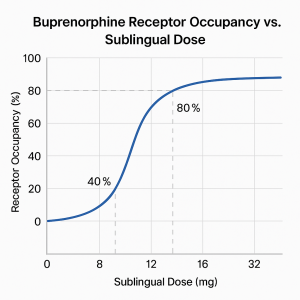
Receptor Occupancy & Detailed Pharmacodynamics
PET imaging studies reveal how buprenorphine affects mu-opioid receptor (μ‑OR) binding at different doses:
-
2 mg SL achieves ~41–50% μ‑OR occupancy, sufficient to suppress withdrawal with minimal respiratory depression.
-
16 mg SL increases occupancy to ~79–84%, providing strong analgesia and robust blockade against opioid cravings.
-
32 mg SL reaches a plateau near 84–98%, reflecting full receptor saturation without increased respiratory risk.
These occupancy levels correspond with plasma concentration thresholds:
-
~1 ng/mL plasma (≈50% occupancy) stops withdrawal symptoms;
-
~3 ng/mL (≈80% occupancy) blocks euphoric effects of full agonists.
Additionally, buprenorphine functions as a κ- and δ‑opioid receptor antagonist, which may partly explain its mood-stabilizing effects and reduced craving intensity.
Neuropharmacology Deep Dive: Mixed Opioid Receptor Actions
-
High-affinity partial agonist at μ-opioid receptors (MOR): Buprenorphine provides strong analgesia and withdrawal relief with limited respiratory suppression, due to its ceiling effect.
-
Antagonist at κ-opioid receptors (KOR): By blocking KORs, buprenorphine may reduce dysphoria and stress-related relapse. Animal and human studies link KOR antagonism to antidepressant-like effects.
-
Antagonist at δ-opioid receptors (DOR): Buprenorphine also inhibits DOR, which modulates mood and pain sensitivity. This “multi-receptor inhibition” may enhance mood stabilization and reduce opioid cravings.
-
Dual action explained: Its MOR partial agonism controls pain and withdrawal, while KOR/DOR antagonism potentially improves mood and mitigates emotional dysregulation common in OUD
Buprenorphine vs. Methadone: Which Works Better?
Both medications effectively reduce opioid use and lower mortality rates in OUD treatment. Methadone often shows better patient retention, but buprenorphine offers safer administration (including at-home dosing), easier initiation, and no need for daily clinic visits. Critically, buprenorphine is associated with better neonatal outcomes—like higher birth weight and lower preterm delivery—making it a preferable option in pregnancy
“Microdosing” or low-dose induction (Bernese Method) involves starting buprenorphine at tiny doses (≈0.2–0.5 mg) while the patient remains on full opioids. The dose increases gradually over several days. This method allows smooth transition with minimal withdrawal, and is especially effective in fentanyl or methadone users
What Is Buprenorphine Microdosing (Bernese Method)?
Also known as low-dose or micro-induction, microdosing begins buprenorphine at very low levels while the patient still uses full opioids. This minimizes precipitated withdrawal—a common barrier to starting treatment—and is especially effective for transitioning from long-acting opioids like fentanyl
Microdosing Limitations & Guidance
A 2025 JAMA Network Open study found that only about 34% of fentanyl users completed a 4-day microdosing induction, and just 21% succeeded after 7 days .
Microdosing may be less effective for high-potency opioid users (e.g. fentanyl), and extended taper schedules may be required .
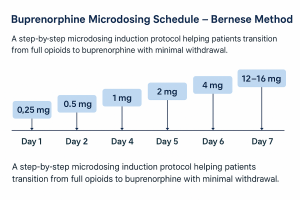
Microdosing Protocol & Clinical Success Rates
A widely used low-dose induction approach begins with 0.25–0.5 mg sublingual (SL) buprenorphine once or twice per day over 5–7 days, gradually increasing to maintenance doses. For example, the Bernese Method protocol may look like:
-
Day 1–2: 0.25–0.5 mg SL once daily
-
Day 3–4: 1–2 mg SL twice daily
-
Day 5–6: 3–4 mg SL twice daily
-
Day 7: Shift to 12–16 mg SL once daily and discontinue full opioids
Recent studies highlight its variable effectiveness:
-
A JAMA Network Open study of 126 fentanyl-using adults found just 34% succeeded in achieving full buprenorphine induction after four or seven days using this method. By day 28, only 21% (4-day protocol) and 18% (7-day protocol) remained on medication.
-
UCSF research shows 38% success at day 4 and 28% at day 7, with overall induction success at 34%.
These findings suggest induction may require individualized planning—especially for patients using high-potency opioids like fentanyl. Longer microdosing schedules or traditional taper methods may offer safer alternatives
A proven microdosing protocol begins with 0.25–0.5 mg SL on Day 1–2, then increases daily (e.g., 1mg Day 3, 2mg Day 4, 4mg Day 6, 12mg Day 7). However, studies show only 34% success in fentanyl users during this protocol—indicating that higher-potency opioid users may need longer induction plans or traditional taper methods
Benefits of Long-Acting Buprenorphine (Sublocade®, Buvidal®)
Long-acting formulations provide once-monthly injections or implants that ensure consistent drug levels and reduce opportunities for daily misuse. Clinical data shows these formulations achieve higher treatment retention and fewer diversions compared to daily oral buprenorphine .
Long-Acting Formulation Efficacy & Clinical Data
Clinical trials demonstrate that RBP‑6000 (SUBLOCADE/BUP‑XR) monthly injections deliver deep opioid blockade and strong treatment outcomes:
- A phase II trial administering two 300 mg subcutaneous RBP‑6000 doses (Day 1 and Day 29) showed complete blockade of subjective hydromorphone effects for up to 12 weeks. Drug-liking VAS scores remained within ≤ 10 mm of placebo across all hydromorphone challenges, indicating sustained receptor blockade.
Exposure–response modeling from phase III data indicates plasma concentrations ≥ 2–3 ng/mL—achieved with initial monthly dosing—provide ≥ 70% μ-opioid receptor occupancy and effective opioid abstinence in most patients. However, opioid-injecting individuals often require a 300 mg maintenance dose to maintain higher receptor occupancy (5–6 ng/mL) and improve treatment retention and opioid-negative outcomes.
Compared to sublingual buprenorphine, depot injections reduce the risk of daily dose diversion, promote adherence, and are especially beneficial for patients with adherence concerns or frequent missed doses.
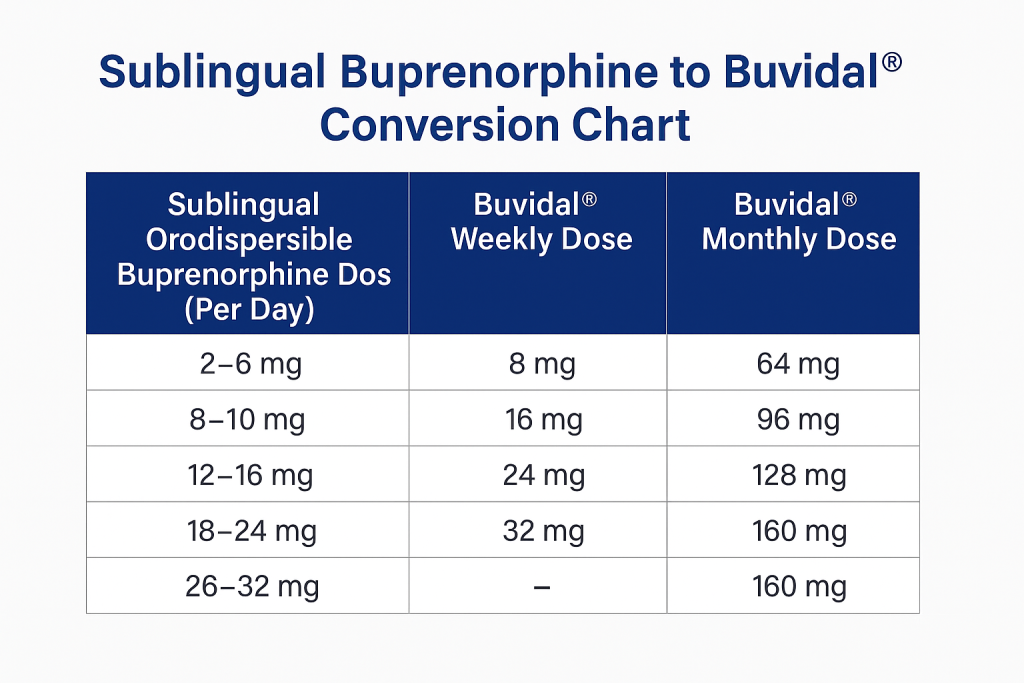
Clinical Takeaway: For most patients, the standard 300 mg monthly RBP‑6000 dosing achieves sustained blockade and efficacy. In opioid-injecting or high-tolerance individuals, evidence supports continuing monthly 300 mg maintenance to optimize outcomes.
Long-Acting Formulation Conversion Table
| Daily SL BPN Dose | Weekly Buvidal® | Monthly Buvidal® |
|---|---|---|
| 2–6 mg | 8 mg | — |
| 8–10 mg | 16 mg | 64 mg |
| 12–16 mg | 24 mg | 96 mg |
| 18–24 mg | 32 mg | 128 mg |
| 26–32 mg | — | 160 mg |
Table: Conversion from daily sublingual buprenorphine (BPN) to Buvidal® weekly/monthly dosing, based on Buvidal prescribing guidelines.
Sublocade® (RBP‑6000) – Efficacy Results from Phase III Trials
-
In a 24-week Phase III study (NCT02357901) of 504 adults with moderate–severe OUD, monthly 300 mg doses of Sublocade yielded:
-
43% opioid-free weeks in the 300 mg/100 mg group and 41% in the 300 mg/300 mg group, compared to just 5%on placebo—with a statistically significant difference (P < 0.0001).
-
A 28–29% treatment success rate (≥80% opioid-free weeks) in the two Sublocade arms, versus 2% in the placebo group (P < 0.0001) .
-
Discontinuation rates were lower in active treatment groups (~36–38%) vs placebo (66%).
-
-
A 12-week opioid blockade study demonstrated near-complete suppression of hydromorphone-induced drug liking at both 6 mg and 18 mg doses post-Sublocade 300 mg injection
Buprenorphine vs. Methadone in Pregnancy
Controlled studies and large cohorts show that pregnant individuals on buprenorphine experience significantly fewer complications: infants have higher birth weights, lower rates of premature delivery, and reduced neonatal abstinence syndrome. Maternal outcomes—like cesarean rates and severe complications—remain similar between buprenorphine and methadone groups
Freedom Starts Here. Take Back Your Life Today.
Same-Day Admissions in Austin Available.
Frequently Asked Questions – Buprenorphine
What is the buprenorphine ceiling effect?
Buprenorphine is a partial μ‑opioid agonist that offers full pain relief while limiting respiratory depression. Beyond doses of 12–16 mg, increasing the dose doesn’t provide stronger effects—making it safer than full opioids.
How does buprenorphine compare to methadone?
Both reduce opioid use and mortality effectively. Methadone offers slightly higher retention but requires clinic dosing. Buprenorphine is prescription-based, safe in pregnancy, and achieves similar long-term results.
What is buprenorphine microdosing (Bernese Method)?
Microdosing starts buprenorphine at tiny doses (0.25–0.5 mg), while on full opioids, and gradually increases over days. This reduces the risk of withdrawal—especially with fentanyl or methadone users.
What are the benefits of long‑acting formulations?
Monthly injectables (Sublocade, Buvidal) and implants (Probuphine) maintain steady drug levels, improve adherence, eliminate daily dosing, and reduce diversion risk—studies show higher retention rates.
Is buprenorphine safe for pregnancy?
Yes—studies show buprenorphine leads to higher birth weights and fewer neonatal abstinence symptoms compared to methadone. Breastfeeding is generally considered safe due to low transfer (<2%).
What is the withdrawal timeline for buprenorphine?
Withdrawal usually begins within 1–3 days, peaks in week one with symptoms like anxiety and insomnia, and resolves in 2–4 weeks. It is typically milder than full opioid withdrawal.
How does Suboxone differ from buprenorphine alone?
Suboxone includes naloxone to prevent injection misuse. When taken as directed, naloxone remains inactive—but if injected, it triggers withdrawal—enhancing safety against diversion.
Can you overdose on buprenorphine with other drugs?
Buprenorphine alone carries low overdose risk due to its ceiling effect. Mixing it with benzodiazepines, alcohol, or full opioids significantly increases respiratory depression and overdose danger.
Frequently Asked Questions – Buprenorphine Deep Dive
Can buprenorphine cause central sleep apnea?
Yes. Case reports have shown central sleep apnea (CSA) developing during initiation or maintenance on buprenorphine-naloxone. In a documented case, a female patient’s CSA resolved after her dose was reduced.
What is κ-receptor antagonism and why does it matter?
Buprenorphine acts as a kappa-opioid receptor (KOR) antagonist, which helps reduce dysphoria, stress-related relapse, anxiety, and depression. This action supports its mood-stabilizing and craving-reducing effects.
Which long-acting buprenorphine formulation suits me best?
Choice varies by treatment goals:
• Sublocade®: Best for high-demand patients—300 mg monthly blocks opioid effects with strong retention
• Buvidal®: Flexible weekly/monthly dosing, needle-free, non-inferior abstinence to sublingual
• Probuphine®: Ideal for stable low-dose patients (≤ 8 mg SL/day), lasts 6 months
• Butrans® patch: Approved for chronic pain only, not indicated for OUD
What dosing schedule is used in buprenorphine microdosing?
A typical 7-day Bernese microdose titration may start at 0.25 mg SL on Days 1–2, increase to 1–2 mg twice daily on Days 3–4, and reaches 12–16 mg by Day 7. This helps reduce withdrawal risk during induction.
How much receptor occupancy does 16 mg buprenorphine achieve?
PET imaging confirms that 16 mg sublingual buprenorphine occupies approximately 79–84% of μ-opioid receptors—high enough for analgesia and craving suppression without heightened respiratory risk.
Is buprenorphine safe while breastfeeding?
Yes. Breastfeeding during stable buprenorphine treatment is supported: transfer into milk is <2% of maternal dose, and infant exposure remains low. Monitoring for drowsiness is recommended.
More Time. More Joy. More You. Start Now.
WE ACCEPT MOST INSURANCES







If you’re ready to overcome opioid dependence, buprenorphine offers a scientifically backed, effective path forward. As a partial opioid agonist, it reduces withdrawal symptoms and cravings, provides a ceiling on overdose risk, and enhances safety compared to full opioids like methadone or heroin. When combined with evidence-based counseling and ongoing support in a medication-assisted treatment (MAT) program, buprenorphine helps restore balance, reduce overdose risk, and empower lasting recovery .
At Nova Recovery Center, our buprenorphine treatment program is tailored to meet your unique needs—from clinically supervised initiation and maintenance to tapering when appropriate. We pair pharmacotherapy with compassionate therapy, peer support, mental health care, and relapse prevention planning. Our goal is to guide you toward sustained stability, well-being, and freedom from opioid addiction.

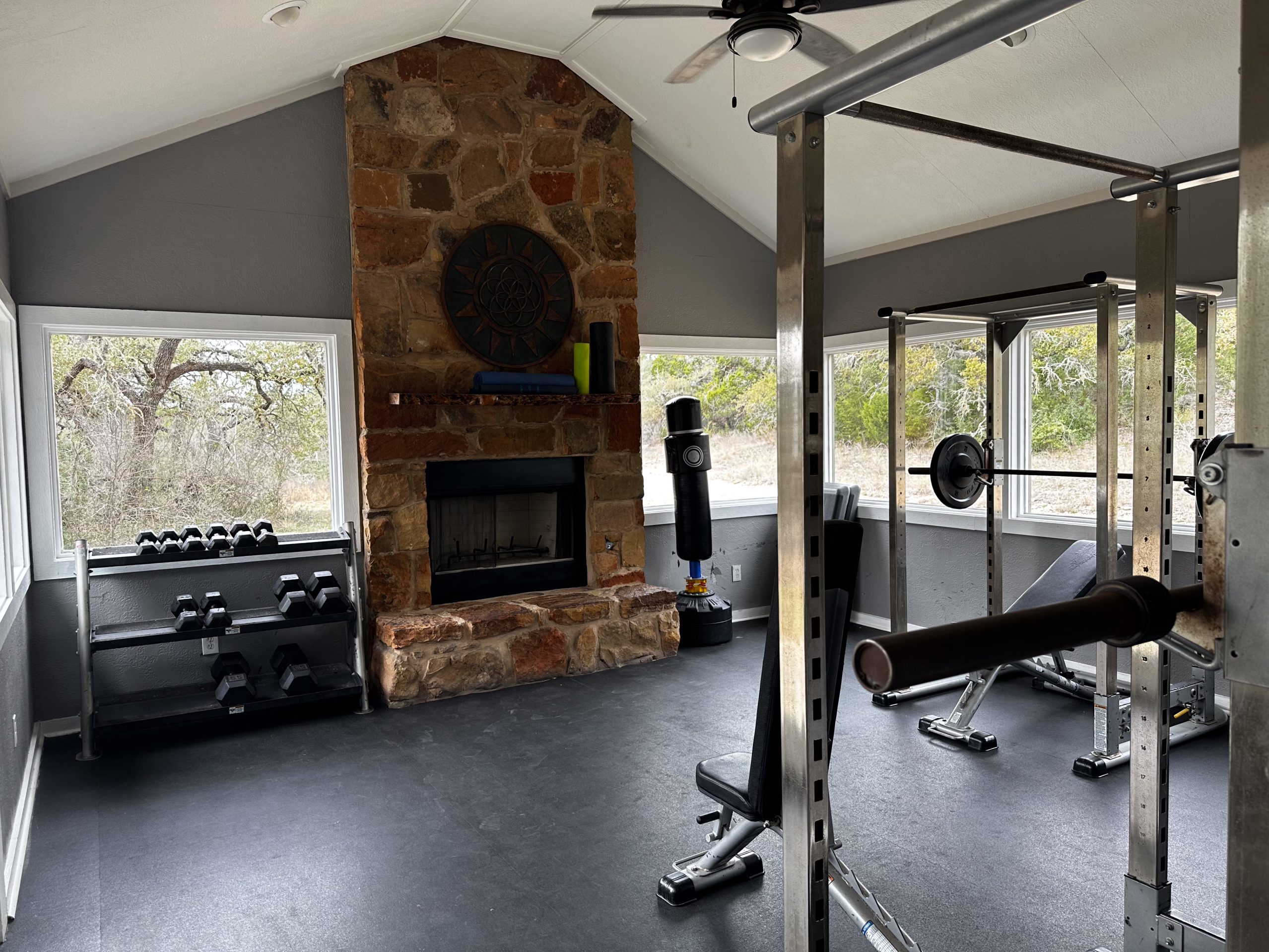
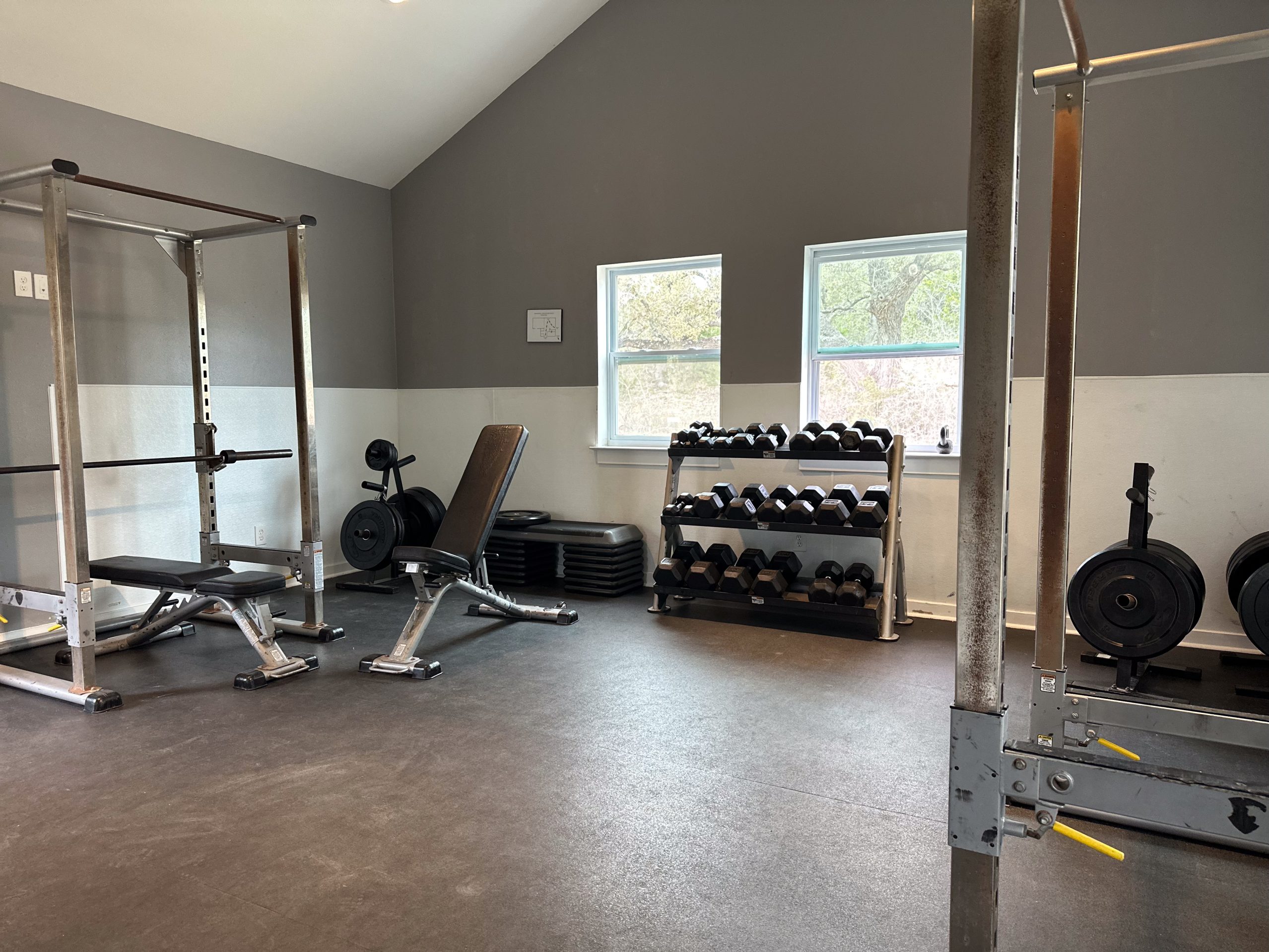

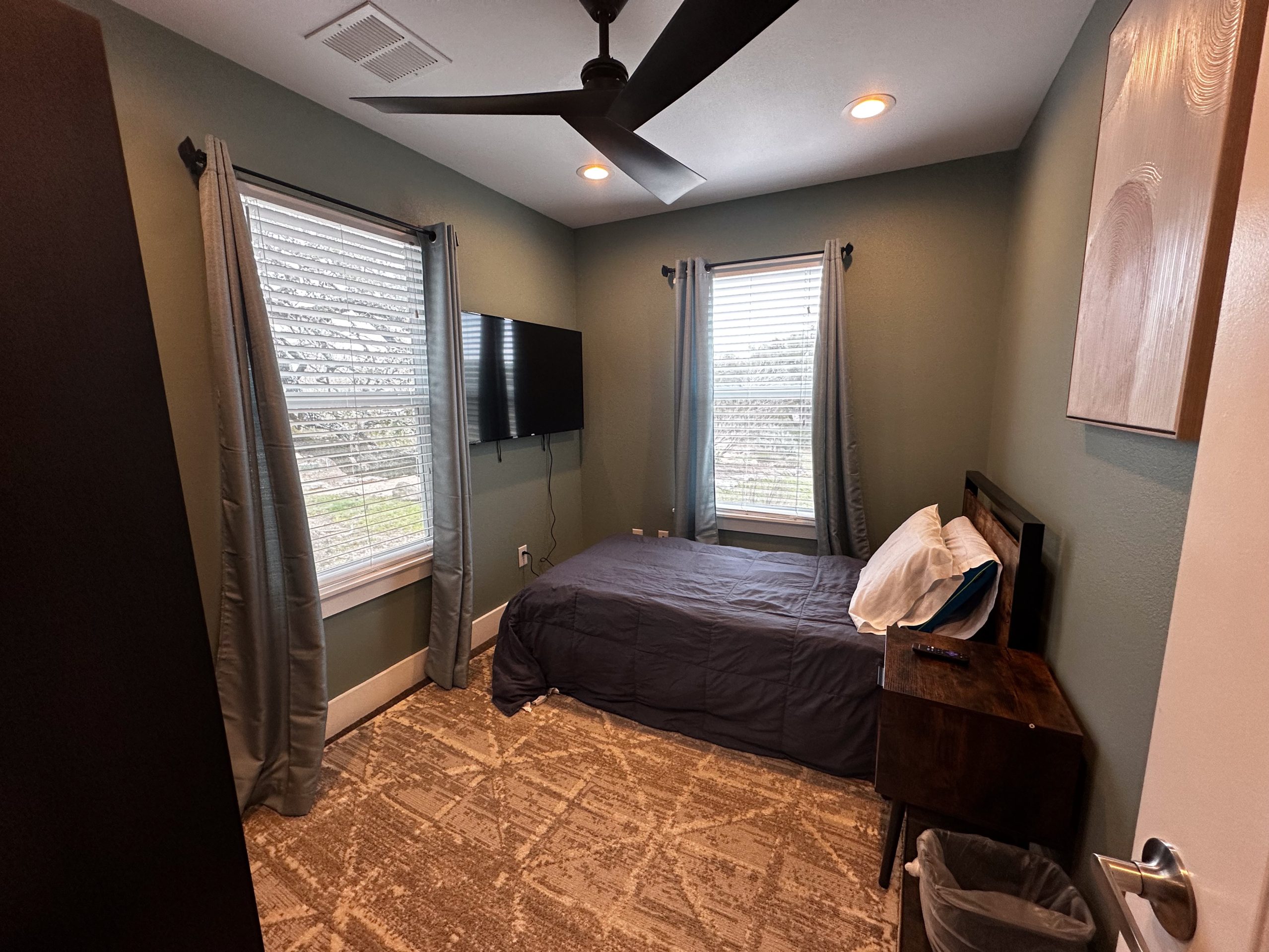





Our Drug and Alcohol Rehab Services in Texas
Freedom Starts Here. Take Back Your Life Today.
Same-Day Admissions in Austin Available.
Nova’s Comprehensive Continuum of Care Plan
90-Day Residential Alcohol and Drug Rehab

Our 90-day residential drug and alcohol rehab in Austin center provides a safe, comfortable, and supportive space for you to heal, learn, and recover. Unlike other 30 or 60-day programs, our long-term rehab program gives you more time to adjust to a new way of living, more time to practice the mental and spiritual tools you will use outside of rehab, and more time to acclimate into a recovery community. This 90-day time span promotes genuine and lasting change for sobriety that lasts long after inpatient rehab ends.
Drug and Alcohol Detox

Our medical detox programs treat all kinds of addictions and are tailored to meet your individual needs. We use a comprehensive assessment to design a personalized detox program that will ensure your comfort and safety throughout the withdrawal process. You’ll also have the opportunity to begin individual and group therapy to address any emotional issues and prepare for the transition into a rehab program. We believe this process provides the best foundation for continued sobriety.
Aftercare Program and IOP

Our Intensive Outpatient and Aftercare programs are designed to assist those who have graduated from our inpatient residential facility. Group sessions are available in Austin and Houston and provide structured addiction treatment sessions and recovery counseling in a safe, clinical setting. The first year of recovery can be difficult, but these support groups provide consistency, accountability, and peer support at a time when it’s needed most.
Sober Living Apartments

The transition from a residential rehab center into independent sober life is littered with obstacles. For this reason, we provide sober living homes and support programming for clients who need continued support as they make the transition. With regular drug and alcohol screenings, one-on-one sobriety coaching, and a safe, comfortable place to practice relapse prevention strategies, our sober living program is key to achieving an independent, substance-free life.
More Time. More Joy. More You. Start Now.
WE ACCEPT MOST INSURANCES













